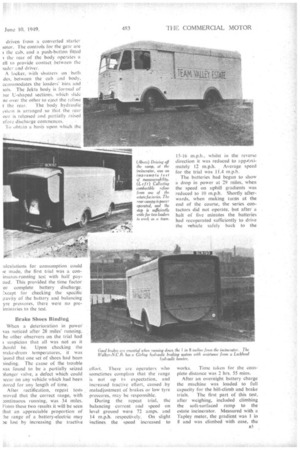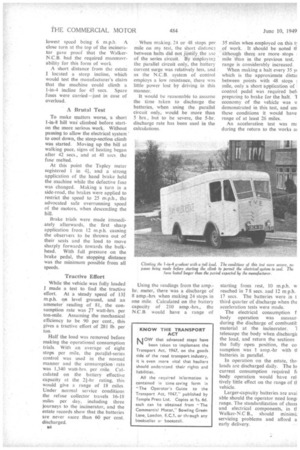MORE STOPS LONGER RANGE
Page 10

Page 11

Page 12

If you've noticed an error in this article please click here to report it so we can fix it.
Battery electric Refuse Vehicle Shows Marked Economy in Door-to-door Collection. Powerful Twin Motors Ensure that I in 4 Gradients Can Be Climbed With Full Load
IT is .unusual to find a . vehicle Which is more economical when
. the number of stop S per mile is increased", but Such is the case with the Walker-N.C.B. refuse collector This model, lent by the Team Valley Trading Estate authorities, was tested during a week-end under normal operating conditions on the estate._ The operator is using this — vehicle to collect combustible material from the factories,the load being bulky, but much less than the rated weight capacity of the machine To comply with the conditions of areas where denser refuse is carried_ the body was loaded to half-capacity for consumption trials, and the full load of 4 tons was carried for a I-in-4 hill-climb and brake tests.
Basically. the chassis is a modified version of the Walker refuse collector, with alteration. to the wheelbase length to accommodate the standard battery containers The Walker steering, frame, front axle and bevel final drive are retained, but
B2 the rear-axle banjo is sturdier, and the Girling hydraulic-brake system is boosted from a Lockheed servo unit driven from the propeller shaft Layrub couplings are used in the transmission between the reduction' box and the rear axle, and in the two input shafts connecting the motors to the reduction box Electrical components common to other models of the N.C.B range are used, thus maintaining a measure of standardization The two B.T.14 motors, each of 121 h p. at the onehour rating, are permanently coupled in series, whilst the solenoid-contactor control gear is arranged for parallel-series battery operation to give economic half-speed operation " The economy of this arrangement was proved during the tests of 24 and 48 stops per, mile Depression of the pedal brings the parallel cOntacts into action, and a push-button control completes the series circuit to increase the speed to maximum Two double-action fuses protect the electrical system from overload or short circuit A master controller switch incorporated in the system isolates the control panel for adjustment, and as a safeguard against theft. The charger socket cover acts as a make-or-break circuit to prevent the vehicle from being driven while still connected ie the charger Batteries Easily Accessible Housed in four crates, the Exide Lighterweight batteries are carried pannier-fashion on the frame side members. Panels in the side of the body provide access for their maintenance or removal The control pane] is positioned behind the driver's seat, and, except for the hydraulic tank for body operation, the remaining two-thirds of the cab space is available for seating the loaders_ A front hinged door and step placed forward of the front axle provide easy entry to the cab The gearfor operating the Jekta body is housed behind the cab; and
driven from a converted starter iotor. The controls for the gear are the cab, and a push-button fitted ) the rear of the body operates a ell to provide contact .between the tatter and driver. •
A locker.Avith shutters on -both des, between the cab and • body, ecomomdates the loaders' bins and )ols. The Jekta body is formed of )ur U-shaped sections,which slide ne over the other to .eject the refuse
t the rear. The body hydraulic ystem is arranged .so that the rear nor is released and .partially raised efore discharge commences. • •To obtain a basis -upon which the
:alculations for consumption could le made, the first trial was a coninuous-running test with half payoad. This provided the time factor or complete battery discharge. Ncept for checking the specific p-avity of the battery and balancing yre pressures, there were no preiminaries to the test.
Brake Shoes Binding
When a deterioration in power" as noticed after 28 miles' running, he other observers on the trial had suspicion that all was not as it bould be. Upon checking the mike-drum temperatures, it was otind that one set of shoes had been )inding. The cause of the trouble was found to be a partially seized Atinger valve, a defect which could )ccur on any vehicle which had been aored for any length of time.
After rectification, repeat tests ,roved that the correct range, with :ontinuous running, was 34 miles. From these two results it will be seen that an appreciable proportion of he range of a battery-electric May 3e lost by increasing the tractive effort. There are operators who sometimes complain that the 'range is not up to expectation, and increased tractive effort, caused by maladjustment of brakes or low tyre pressures, may be responsible.
During the repeat trial, the balancingcurrent and speed on level ground were 72 amps. and 14 m.p.h. respectively. On slight inclines the speed increased to
15-16 m.p.h., whilst in the reverse direction it was reduced to appi,mi mately 12 m.p.h. Average speed for the trial was 11,4 m.p.h.
The batteries had begun to show a drop in power at 29 miles, when the speed on uphill gradients was reduced to 10 m.p.h. Shortly afterwards, when making turns at the end of the course, the series contactors did not operate, but after a halt of five minutes the batteries had recuperated sufficiently to drive the vehicle safely back to the works. Time taken for the com plete distance was 2 hrs. 55 mins. After an overnight battery charge the machine was loaded to full capacity for the hill-climb and brake trials. The first part of this test, after weighing, included climbing the soft-surfaced ramp to the estate incinerator. Measured with a Tapley meter, the gradient was I in 8 and was climbed with case, the
lowest speed being 6 m.p.h. A close turn at the top of the incinerator gave proof that the WalkerN.C.B. had the required manceuvrability for this form of work A short distance from the estate I located a steep incline, which would test the manufacturer's claim that the machine could climb a 1-in-4 incline for 45 secs. Spare fuses were carried—just in case of overload.
A Brutal Test To make matters worse, a short 1-in-8 hilt was climbed before starton the more serious work. Without pausing to allow the electrical system ' to cool down, the steep-section climb was started. Moving up the hill at walking pace, signs of heating began after 42 secs., and at 48 secs the fuse melted.
At this point the Tapley meter Registered 1 in Q, and a strong application of the hand brake held the machine while the defective fuse was changed. Making a turn in a side-road, the brakes were applied to restrict the speed to 25 m.p.h., the advocated safe overrunning speed of the motors, when descending the hill.
Brake trials were made immediately afterwards, the first sharp application from 12 m.p.h. causing the observers to he thrown out of their seats and the load to move sharply forwards towards the bulk head. With full pressure on the brake pedal, the stopping distance was the minimum possible from all speeds.
Tractive Effort
While-the vehicle was fully loaded I made a test to find the tractive effort. At a steady speed of 132 mph. on level ground, and an ammeter reading of 81, the consumption rate was 77 watt-hrs. per ton-mile. Assuming the mechanical efficiency to be 90 per cent., this gives a tractive effort of 284 lb. per ton.
Half the load was removed before making the operational consumption trials. With an average of eight stops per mile, the parallel-series control was used in the normal manner and the consumption rate was 1,340 watt-hrs. per mile. Calculated on the battery effective capacity at the 2i-hr rating, this would give a range of 18 miles. Under normal service conditions the refuse collector travels 16-18 miles per day. including three journeys to the incinerator, and the estate records show that the batteries are never more than 60 per cent. discharged. When making. 24 or 48 stops per mile on my test, the short distance between halts did not jUstify the use of the series circuit. BY employin; the parallel circuit only, the battery current surge was relatively less, and as the N.C.B. system of control employs a low resistance, there was little power lost by driving in this manner.
It would be reasonable to,assume the time taken to discharge the batteries, when using the parallel circuit only; would be more than 5 hrs , but to be severe, the 5-hr. discharge rate has been used in the calculations.
Using the readings from the amp.hr. meter, there was a discharge of 8 amp.-hrs when making 24 stops in one mile. Calculated on the battery capacity of 210 arnp.-hrs., the N.C.B. would have a range of 35 miles when employed on this I.! of work. It should be noted ti although there are more stops mile than in the previous test. range is considerably increased.
When making a halt every 35 yi which is the approximate distal between points with 48 stops mile, only a short application of control pedal was required befi preparing to brake for the halt. 1 economy of the vehicle was la demonstrated in this test, and tin( these conditions it would have range of at least 26 miles.
An acceleration test was ME during the return to the works al
starting from rest, 10 m.p.h. w reached in 78 secs. and 12 m p.h. 17 secs. The batteries were in t third quarter of discharge when the acceleration tests were made.
The electrical consumption f body operation was measuo during the discharge of combustit material at the incinerator. 1 telescope the body when dischargil the load, and return the sections the fully open position, the co sumption was 1 amp.-hr with ti batteries in parallel.
In operation on the estate, thia loads are discharged daily. The lo current consumption required fi body operation would have rel: tively little effect on the range of ti vehicle.
Larger-capacity batteries are avai able should the operator need long' range. The standardization of chass and electrical components, in ii Walker-N.0 B., should minimi: servicing problems and afford a early delivery.


























